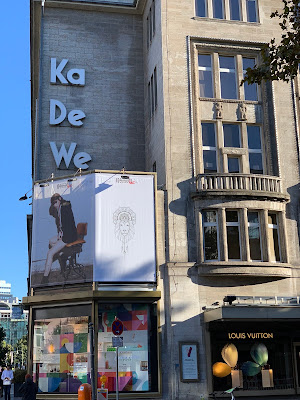Unfortunately, I first found Berlin’s KaDeWe (Europe’s second largest department store after Harrod’s in London) on a Sunday when it was closed.
But I was determined and returned the following evening.
Only a fleeting visit to the business end of the store, I’m afraid because I have no room in my suitcase or my wardrobe back home but rest assured it was wall to wall luxe.
I did pause to appreciate the Aesop counter. Australia is never too far away from here in Berlin. It’s a lovely, reassuring feeling.
Bottles of perfume with lids that look like records arranged to look like a pop art flower. I was so tempted to test them out then and there but more pressing matters called.
Namely the sixth floor food court.
It just seemed like most normal and civilised thing to do on a Monday evening at the shops.
Sydney, why are you not onto this?
No one was being unruly. No one was red faced. There was no crazed shrieking. Just a bar of people sedately sipping their flutes of champagne.
Which reminds me, I’ve got to get started on the gifts I need to bring home for everyone.
I wonder what a day in the life of a visual merchandiser at a food hall such as KaDeWe’s would be like.
The inventive ways they think of to display everyday foods as well as more exotic items.
There’s a touristy feeling to Checkpoint Charlie these days that belies its blood stained history.
 |
| One of the many tourist friendly businesses on the streets surrounding the former checkpoint. |
The official Checkpoint Charlie Museum is nowhere near as touristy as its surroundings.
Along with incredible detail about every aspect of the politics that precipitated the formation of the checkpoints, it also makes some powerful statements about other dictatorships around the world.
Trabis or Trabants as they were officially known are cars manufactured by the VEB car company of the former GDR (East Germany). The cars were made for 30 years and have a steel frame and solid plastic bodies. Unfortunately they were infamously unreliable and have been nicknamed ‘a spark plug with a roof’. These days, Trabis travel the streets of Berlin is vehicles for tourists to self drive around the city.
The museum is located on land that was previously occupied by head offices of the SS. The original buildings were largely destroyed by Allied forces during World War II.
The cellars in the bottom half of this photo were used to torture and hold political prisoners.
Sections of the Berlin Wall remain erect here and it’s the second longest remaining stretch of wall after the Eastside Gallery.
There are some incredibly brave and ingenious people who attempted to escape the East by parachuting and abseiling over this section of the wall and lived to tell the tale. Their plans depended on gaining access to the buildings directly next to the wall.





































